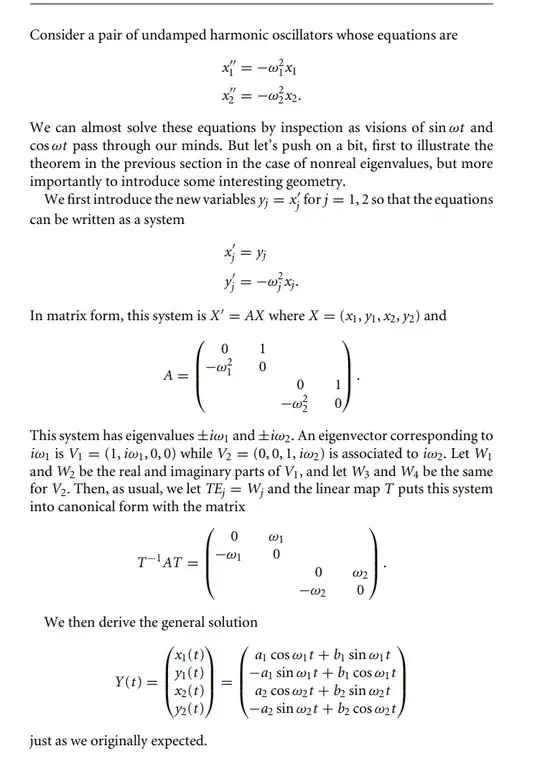For brevity let us focus on the example worked out in the book. One can switch from the general solution of an ODE to its flow is by determining the relationship between an anonymous initial condition and the constants $a_1,a_2,b_1,b_2$. More specifically, setting up $t=0$, if $a_1,a_2,b_1,b_2$ are the coefficients of the unique solution of the ODE with initial condition $Y_0=(y_0^1,y_0^2,y_0^3,y_0^4)\in\mathbb{R}^4$, then we have
$$ \begin{pmatrix}
a_1 \\
a_2 \\
b_1 \\
b_2
\end{pmatrix}= Y(0) = Y_0 = \begin{pmatrix}
y_0^1 \\
y_0^2 \\
y_0^3 \\
y_0^4
\end{pmatrix}.$$
Thus
\begin{align*}
\Phi_t(Y_0)
&
= \begin{pmatrix}
y_0^1\cos(\omega_1 t)+y_0^2 \sin(\omega_1 t) \\
-y_0^1\sin(\omega_1 t)+ y_0^2 \cos(\omega_1 t) \\
y_0^3\cos(\omega_2 t) + y_0^4\sin(\omega_2 t) \\
-y_0^3\sin(\omega_2 t) +y_0^4 \cos(\omega_2 t)
\end{pmatrix}\\
&= \exp\left(\begin{pmatrix}
0 & \omega_1 & 0 & 0 \\
-\omega_1 & 0 & 0 & 0 \\
0 & 0 & 0 & \omega_2 \\
0 & 0 & -\omega_2 & 0
\end{pmatrix} \right) \begin{pmatrix}
y_0^1 \\
y_0^2 \\
y_0^3 \\
y_0^4
\end{pmatrix}\\
&= \begin{pmatrix}
\cos(\omega_1 t) & \sin(\omega_1 t) & 0 & 0 \\
-\sin(\omega_1 t) & \cos(\omega_1 t) & 0 & 0 \\
0 & 0 & \cos(\omega_2 t) & \sin(\omega_2 t) \\
0 & 0 & -\sin(\omega_2 t) & \cos(\omega_2 t)
\end{pmatrix}\begin{pmatrix}
y_0^1 \\
y_0^2 \\
y_0^3 \\
y_0^4
\end{pmatrix}
\end{align*}
all give the flow $\Phi_\bullet:\mathbb{R}\to GL(4,\mathbb{R})$ of the ODE. In this case the system is completely non-hyperbolic (or elliptic), so the phase portrait considerations is subtle (as Hirsch-Smale-Devaney discuss in the book, the topological picture depends strongly on whether or not the ratio $\omega_2/\omega_1$ is a rational number. Further, each trajectory is trapped inside a $2$-torus inside $\mathbb{R}^4$.). Note that the directions of trajectories are based on the signs of $\omega_1$ and $\omega_2$. Since eigenvalues have no real part there will be no spirals.
It should be noted that if $X'=AX$ is a $4\times 4$ linear system with $A$ having purely imaginary eigenvalues, there are a few other cases that need to be considered separately. The example above is the simplest case, where we have four distinct purely complex eigenvalues. Say $i\lambda,\overline{i\lambda}=-i\lambda,i\mu,\overline{i\mu}=-i\mu$ for $\lambda,\mu\in\mathbb{R}$ are the eigenvalues of $A$. Then the full list is as follows:
$\lambda\neq0, \mu\neq0, \lambda\neq\mu$,
$\lambda\neq0, \mu\neq0, \lambda = \mu$,
$\lambda\neq0, \mu=0$,
$\lambda=0, \mu=0$.
The (real) normal forms in each case are like so:
$ \begin{pmatrix}
0 & \lambda & 0 & 0 \\
-\lambda & 0 & 0 & 0 \\
0 & 0 & 0 & \mu \\
0 & 0 & -\mu & 0
\end{pmatrix} $
$ \begin{pmatrix}
0 & \lambda & 0 & 0 \\
-\lambda & 0 & 0 & 0 \\
0 & 0 & 0 & \lambda \\
0 & 0 & -\lambda & 0
\end{pmatrix} , \begin{pmatrix}
0 & \lambda & 1 & 0 \\
-\lambda & 0 & 0 & 1 \\
0 & 0 & 0 & \lambda \\
0 & 0 & -\lambda & 0
\end{pmatrix}$
$ \begin{pmatrix}
0 & \lambda & 0 & 0 \\
-\lambda & 0 & 0 & 0 \\
0 & 0 & 0 & 0 \\
0 & 0 & 0 & 0
\end{pmatrix},\begin{pmatrix}
0 & \lambda & 0 & 0 \\
-\lambda & 0 & 0 & 0 \\
0 & 0 & 0 & 1 \\
0 & 0 & 0 & 0
\end{pmatrix} $
$ \begin{pmatrix}
0 & 0 & 0 & 0 \\
0 & 0 & 0 & 0 \\
0 & 0 & 0 & 0 \\
0 & 0 & 0 & 0
\end{pmatrix},\begin{pmatrix}
0 & 1 & 0 & 0 \\
0 & 0 & 0 & 0 \\
0 & 0 & 0 & 0 \\
0 & 0 & 0 & 0
\end{pmatrix} , \begin{pmatrix}
0 & 1 & 0 & 0 \\
0 & 0 & 0 & 0 \\
0 & 0 & 0 & 1 \\
0 & 0 & 0 & 0
\end{pmatrix} ,\begin{pmatrix}
0 & 1 & 0 & 0 \\
0 & 0 & 1 & 0 \\
0 & 0 & 0 & 0 \\
0 & 0 & 0 & 0
\end{pmatrix} ,\begin{pmatrix}
0 & 1 & 0 & 0 \\
0 & 0 & 1 & 0 \\
0 & 0 & 0 & 1 \\
0 & 0 & 0 & 0
\end{pmatrix} $.
One can exponentiate these matrices using the standard procedure. Note that these would provide different phase portraits. See Arnold's Ordinary Differential Equations for further details.
